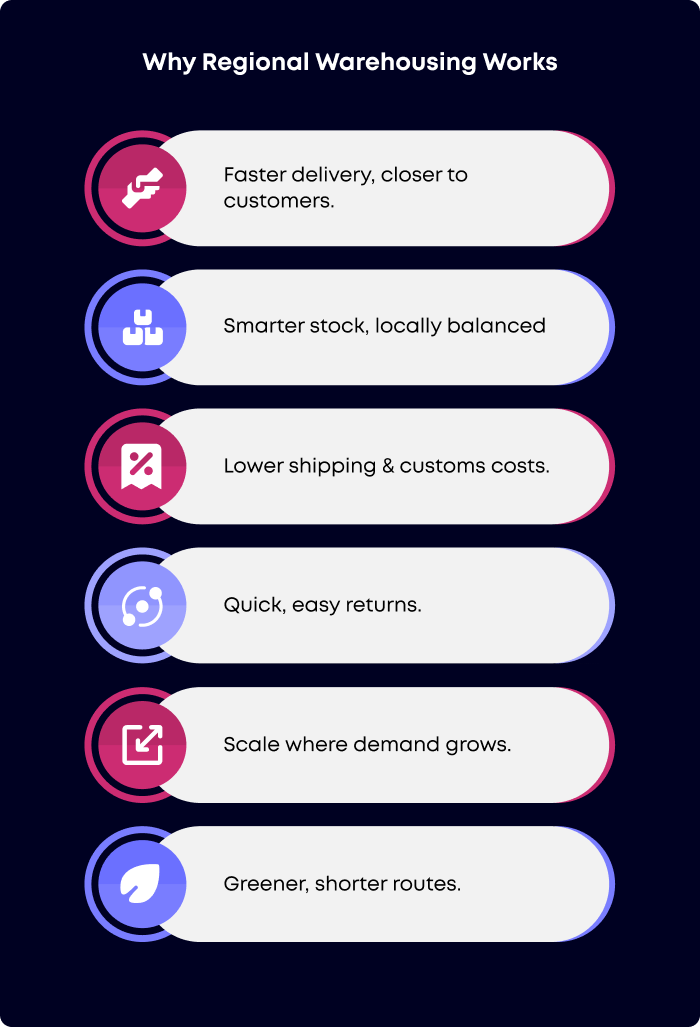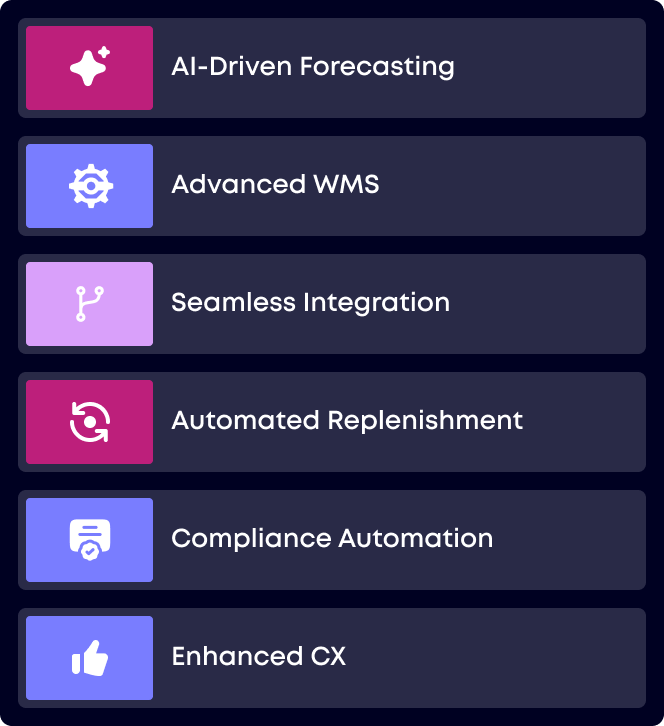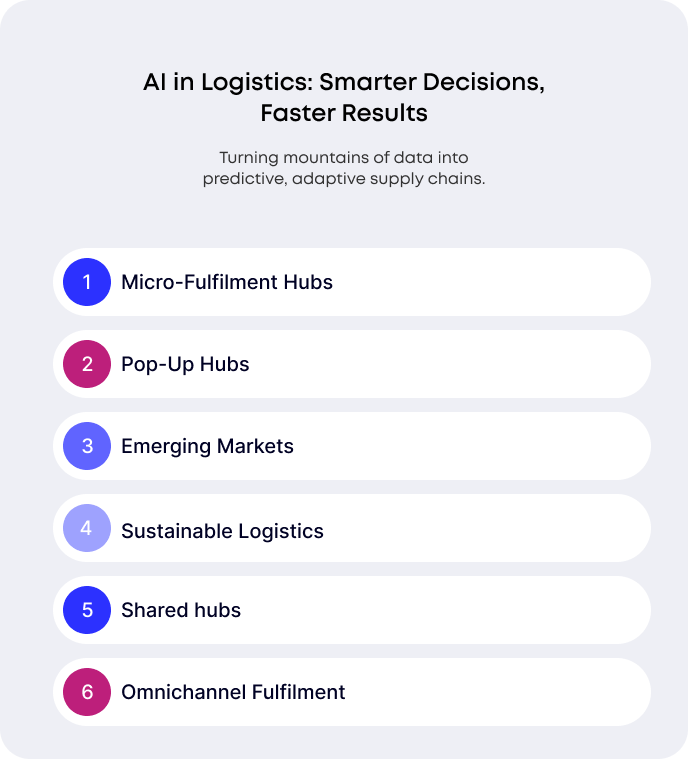Introduction
In the era of global e-commerce, brands are no longer simply shipping from a single mega‐distribution centre to customers worldwide. Instead, they’re increasingly turning to regional warehousing hubs, smaller, strategically placed facilities closer to end markets, that help bridge the gap between global scale and local responsiveness. This shift is reshaping how products are stored, moved, and delivered, and is becoming a key competitive differentiator for brands and logistics providers. In this article we’ll explore what this “rise of regional warehousing” means, why it matters, and how it’s being put into practice including how Filuet supports this evolution.
1. What is Regional Warehousing?
At its core, regional warehousing means locating inventory closer to demand centres, rather than relying exclusively on one or two large central warehouses. These are hubs placed in or near major markets (for example in key cities or cross-border zones), which serve as intermediate fulfilment nodes in a global network.

Its key advantage:
- Faster delivery times because the product is already much closer to the consumer.
- Lower shipping costs for last-mile (and cross-border) segments.
- Better responsiveness to local demand patterns, returns, and market changes.
- Flexibility to scale up or down in a regional hub, rather than building one huge facility.
Why it matters:
Consumer expectations have shifted dramatically: same-day or next-day delivery is becoming the norm in many markets. Companies must react quickly to local surges or shifts in demand. A strategy using regional warehouses helps brands meet expectations while controlling costs and reducing risk (for example risk of delays from long-haul shipments). According to one industry article:
“A well-placed regional warehouse strategy can transform your fulfillment model by cutting delivery times and reducing shipping costs.”
The global e-commerce logistics market is also projected to grow rapidly, meaning that warehousing footprint optimization is going to be increasingly important.
2. The Market Imperative: Why Regional Hubs Are Accelerating
The business case for regional warehousing is strong, and the macro trends reinforce it.

Its key advantage:
- Scale of e-commerce and logistics: the global e-commerce logistics market was estimated at USD 315.82 billion in 2022 and projected to reach USD 1,526.42 billion by 2030 (CAGR ~22.3 %).
- The warehousing segment itself is also expected to grow steadily: one estimate places the e-commerce warehousing market at USD 47.60 billion in 2025, growing to USD 64.32 billion by 2030.
- Regional hubs allow firms to tap emerging markets faster and more cost-effectively: by placing inventory closer to new territories, companies reduce lead times and customs/transport burdens.
- Risk mitigation: supply chain shocks, longer lead times, cross-border delays – these all can be reduced when warehousing is more diversified and regionalised.
Why it matters:
For global brands, being slower or less agile than local competitors in new markets can mean lost market share. Also, cost pressures (rising transport, fuel, labour) make it vital to control the “last mile” portion of the supply chain. Regional warehousing helps address both speed and cost. As one commentary notes, decentralising storage helps companies respond swiftly to market demands and remain competitive.
3. Key Advantages of Regional Warehousing in Practice
Beyond the theory, regional warehousing delivers concrete operational benefits.
Its key advantages:

- Improved delivery experience: With inventory placed closer to customers, brands can offer shorter delivery windows and better predictability.
- Inventory efficiency and risk reduction: Instead of carrying all inventory in one location (with the risk of over/under-stocking), regional hubs allow segmentation of stock by region, offering better inventory turnover and local replenishment.
- Reduced freight and transportation cost: Shipping in bulk to a regional hub followed by shorter last-mile legs tends to cost less, and can reduce duties/customs burden in some cases when local fulfilment is possible.
- Better responsiveness to returns and local support: Regional hubs enable faster returns processing and reverse logistics, enhancing customer service and reducing waste.
- Scalability and flexibility: Brands can scale up operations in particular hubs that show stronger demand, or move under-performing stock elsewhere.
- Sustainability benefits: Shorter transport legs, less cross-border movement, and more efficient regional flows can lower carbon emissions and improve environmental footprint.
Why it matters:
Today’s customer doesn’t just want their parcel, they expect speed, transparency, and reliability. Inventory sitting far away doesn’t support that. Also, brands expanding globally cannot afford to treat every market as an after-thought. Regional warehousing helps translate global ambition into local performance.
4. Critical Considerations When Setting Up Regional Hubs
While the benefits are clear, implementing a regional warehousing strategy carries design and operational complexity.
Its key advantage:

- A well-thought-out network of regional hubs can maximise benefits while minimising complexity. But mis-steps can lead to increased cost and inventory inefficiency.
Why it matters:
Key questions include:
- Location selection: Which markets/hubs make sense? Consider proximity to demand, transport infrastructure, customs/regulatory environment, labour cost.
- Network design: How many regional hubs, what size, how connected to the central/global network? Do you use a hub-and-spoke, or multi-hub design?
- Inventory segmentation & allocation: What stock is held regionally vs globally? How does replenishment between hubs and central centres work?
- Technology and visibility: Real-time inventory tracking, demand forecasting, and local fulfilment systems are required.
- Cost versus service trade-offs: The more hubs, the higher fixed cost; need to balance cost with customer experience gains.
- Cross-border/regulatory issues: Customs, import duties, local warehousing regulations can complicate multi-regional networks.
- Scalability and flexibility: The design should be able to adjust as markets grow, demand patterns change, or new regions open up.
Why this matters in global e-commerce context:
For brands operating across multiple geographies, managing inventory and fulfilment from one location only increasingly becomes a bottleneck. Research shows that e-commerce logistics, warehousing and distribution patterns are evolving because of this shift.
5. Case Study: Regional Warehousing in Action
Intro: Here’s how a global logistics provider supports regional warehousing strategies—and how you might think about applying similar concepts.

Case example:
As shown in the case study “Automated Retail Stores for Herbalife” by Filuet:
- Filuet rolled out smart vending machines in 12 markets, handling warehousing, inventory replenishment, and distribution.
- This required localisation: the machines and associated inventory were placed close to the point of demand, reducing lead times and logistics complexity.
- While not exactly the textbook regional hub, the approach demonstrates the principle of decentralising fulfilment closer to end-users, leveraging local warehousing & replenishment networks.
Why this matters:
It shows that even for physical-retail adjacent models, the logic of being nearer to demand (whether through vending machines, local warehouses or regional hubs) provides speed, flexibility and improved customer experience. For pure e-commerce brands, the same logic applies and can be scaled with regional warehousing infrastructure.
6. The Role of Technology & Data in Regional Warehousing
Intro: Regional warehousing doesn’t just mean more buildings—it demands better systems, data flows and decision-making.

Its key advantages:
- Demand forecasting & inventory allocation: By using data analytics and AI, companies can predict regional demand and allocate inventory to appropriate regional hubs.
- Warehouse management systems (WMS): Modern WMS help manage multi-hub networks, track stock in real time, coordinate replenishment, and optimise order-fulfilment flows.
- Visibility and integration: For a global brand with multiple regional hubs, integrating back-end systems (ERP, 3PL, local fulfilment, transportation) ensures inventory is where it needs to be when it needs to be there.
- Automated replenishment and dynamic allocation: Regional hubs can dynamically ship between each other, adjust to demand spikes, and ensure stock flows efficiently.
- Local compliance and customs automation: Regional hubs often operate under different regulatory regimes, technology helps manage customs documentation, duties, and compliance.
- Customer experience enhancements: Technology supports tracking, transparency, returns handling and faster last-mile delivery, all enabled by regional hub design.
Why it matters:
Without technology underpinning regional warehousing, the cost and complexity can outweigh the benefits. For brands expanding globally, building the “brains” behind the facility network is as important as the “bricks”. It’s the intersection of place + data + process that makes regional warehousing deliver.
7. Looking Ahead: Emerging Trends in Regional Warehousing
As regional warehousing becomes more mainstream, several trends are shaping how companies will adopt and evolve these networks.

Its key advantages / emerging aspects:
- Micro-fulfilment centres and dark stores: Smaller hubs located even closer to ultra-dense urban areas are emerging, enabling ultra-fast delivery (same-day, even hours).
- Flexible / pop-up hubs: Some brands are experimenting with temporary or seasonal hubs near high-demand zones (for events, holidays, regional promotions).
- Regionalisation in emerging markets: Rather than simply “exporting” from central hubs, brands are establishing local warehouses in emerging geographies (Asia-Pacific, Latin America, Africa). The Asia-Pacific region leads in warehousing growth.
- Sustainable logistics: Regional hubs reduce transport distances and may support lower-carbon delivery models; customers and regulators increasingly demand this.
- Collaborative logistics & multi-tenant hubs: Smaller brands may share regional hub capacity (3PL/4PL models) rather than build on their own, improving scalability and cost efficiency.
- Integration with omnichannel fulfilment: Regional hubs aren’t just for online orders, they will increasingly support returns, in-store pickup, B2B fulfilment, and broader channel strategies.
Why it matters:
For brands and logistics providers, planning for tomorrow means thinking beyond a single regional hub. The network needs to adapt, stay flexible, and align with evolving consumer expectations, regulatory pressures, and sustainability demands. Those who build tomorrow’s regional warehousing today gain a competitive edge.
Conclusion
The rise of regional warehousing marks a significant shift in how global e-commerce fulfilment is designed and operated. From quicker delivery times, lower cost last-mile, better responsiveness to local markets, to supporting emerging geographies and sustainability goals, the benefits are compelling. But success hinges on smart network design, strong technology and data capabilities, and operational excellence.
At Filuet, with a market presence across multiple geographies and deep experience in fulfilment and logistics, the role of regional warehouses and local fulfilment hubs clearly aligns with their end-to-end logistics services. As brands continue to expand globally, leveraging regional warehousing strategies with a trusted partner like Filuet can help turn global ambition into local efficiency and customer-centric fulfilment.
If you’re evaluating how to build or optimise regional warehousing for your brand’s global footprint, understanding the trade-offs, capabilities, and partner ecosystem is more important than ever, and Filuet’s expertise in global fulfilment and logistics positions them well to support that journey.
.webp)













